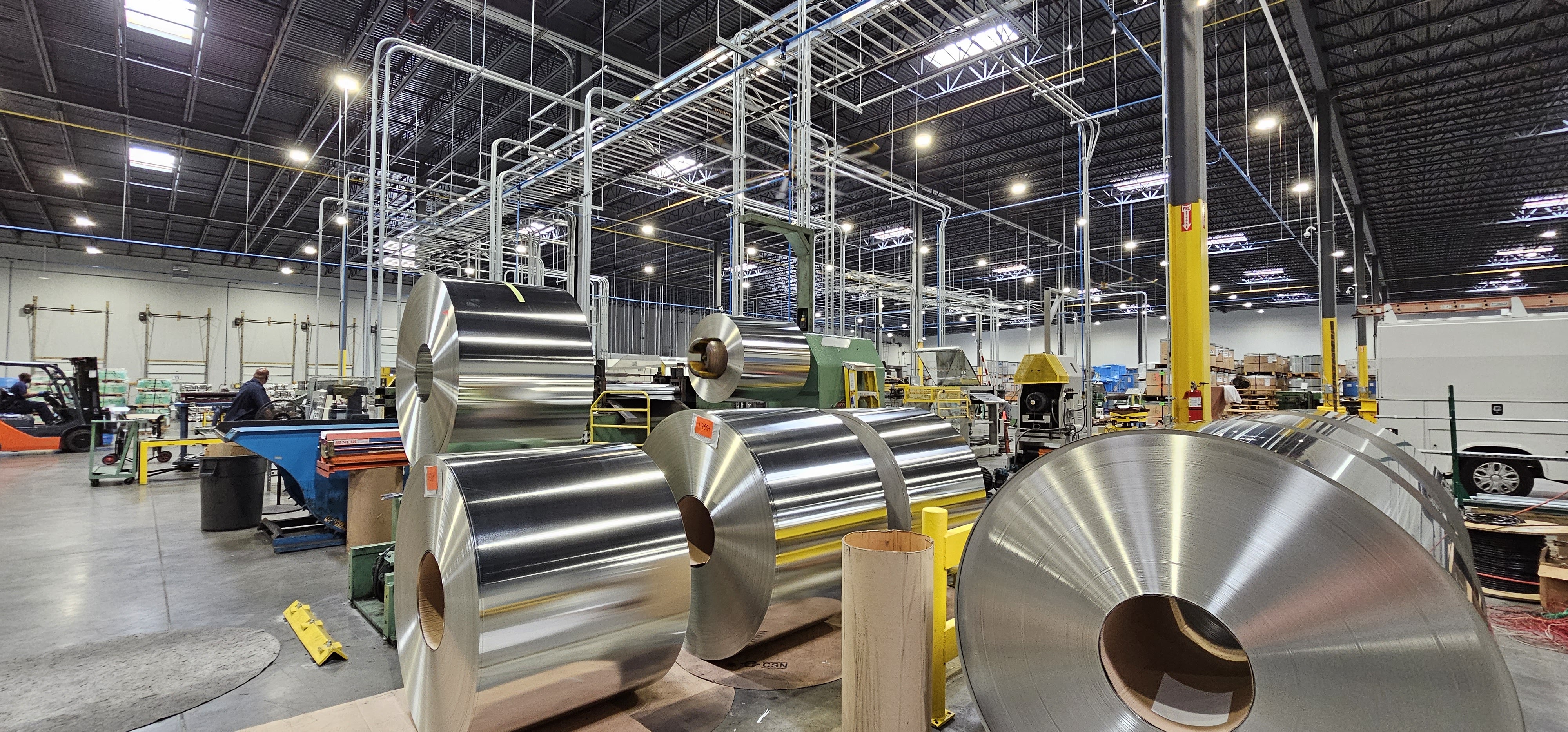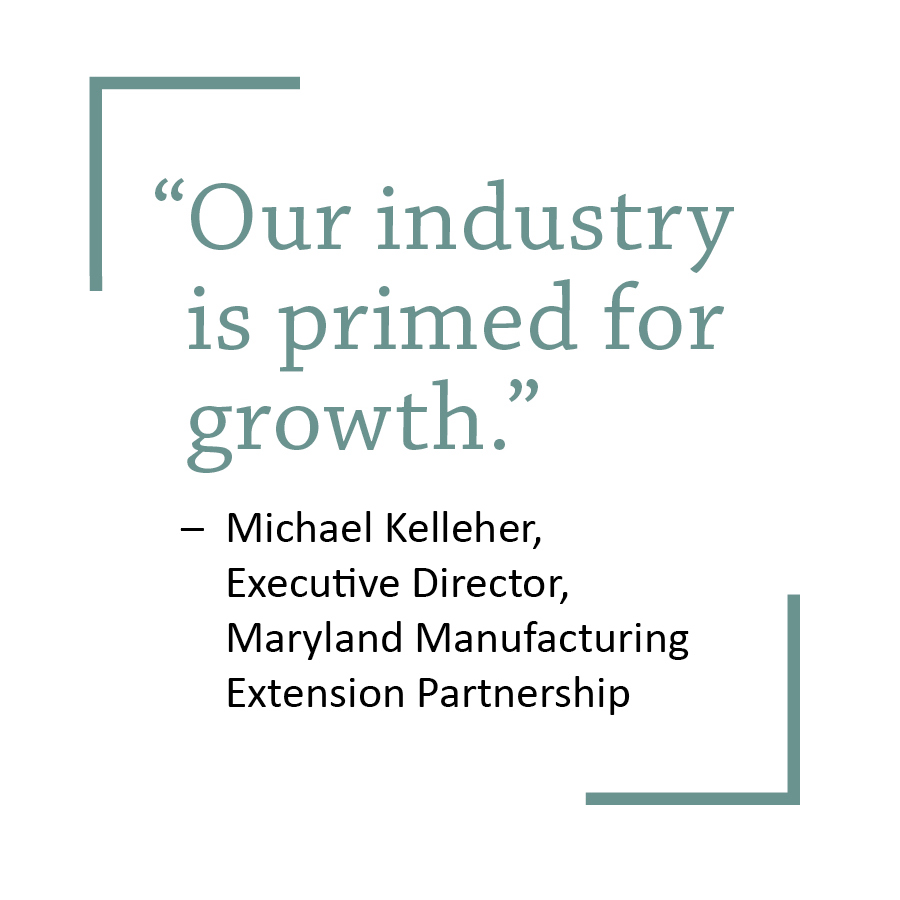After 75 years in the same Baltimore location, Titan Steel Corporation needed to move. The manufacturer of steel and aluminum core products for clients around the world selected a site in Hollander Business Park. Even though the new, 100,000-square-foot, tilt-up concrete building would be designed for industrial use, the project would still have to meet extraordinary requirements for the manufacturer.

Tailoring space for manufacturing tenants, such as Titan Steel Corporation, can require even new construction to add structural, electrical, mechanical and design capabilities. Photo courtesy of Arium AE.
Extra thick slabs were significantly reinforced with steel fibers and rebar to hold the millions of pounds of steel coils necessary for Titan’s manufacturing process. “Non cookie cutter” elements were added to the design, such as drive-in truck bays for loading and offloading pallets of steel, said Bill Gnagey, Senior Associate and Director of Business Development at Arium AE, an architecture and engineering firm working on the project.
“We did numerous surveys of Titan’s proprietary equipment to determine the most efficient layout of the space and to determine power, gas and compressed air requirements. Moving between buildings while keeping up with production was important to the client, so we needed to be sure we had a plug-and-play plan. As soon as the equipment was installed in the new space, they would be able to power up and start work,” said Gnagey, adding that any additional downtime would be very costly for Titan.
Manufacturing may not be the largest driver of industrial real estate development and leasing activity in Maryland. But the state is home to over 4,000 manufacturers, producing everything from spices, power tools and athletic gear to vaccines, medical devices, military equipment and the batteries used in most satellites.
“If you pick a sector and pick a product, I can almost guarantee you that we have someone here in Maryland who makes it,” said Michael Kelleher, Executive Director of the Maryland Manufacturing Extension Partnership. In addition, “our industry is primed for growth.”
Federal and state programs, which support technology adoption and apprenticeships in manufacturing, combined with heightened ‘Buy America’ campaigns, are spurring many Maryland manufacturers to upgrade and/or expand their operations, Kelleher said.
Maryland specializes in high-tech manufacturing, especially in the aerospace/defense, life sciences and food/beverage sectors. Consequently, assorted companies are searching for — and often struggling to find — space that provides the heightened infrastructure that manufacturing requires and that is also located near the company’s workforce and distribution routes, he said.
On a 56-acre site in White Marsh, Merritt Properties is currently developing a nine-building, 749,800-square-foot flex/light industrial park with the heightened needs of manufacturers in mind.
“We are trying to build the most flexible, standardized product we can that a multitude of clients could occupy,” said Whitaker Levering, Leasing Representative at Merritt Properties.
Buildings will range from 32,000 square feet with 20-foot clear heights to 167,000 square feet with 32-foot clear heights.
“We will have the ability to increase the size of dock doors if needed. We are putting in seven-inch floors to begin with, which will meet any requirements a tenant may have,” Levering said. “As a landlord, we have to do our best to be nimble enough to make buildings functional and flexible enough to meet the power requirements, specialty flooring needs and other essentials of manufacturing companies.”
In the course of completing design and engineering services for multiple manufacturing facilities in Maryland, Arium AE has learned just how demanding and complex those projects can be. Even in new developments, such as Hollander Business Park, planned industrial buildings may need significant design changes — such as heavier slabs, additional power or specialized HVAC — to meet the needs of a manufacturer.
Increasingly, project and leasing teams are also being challenged to adapt existing industrial buildings to serve the needs of a manufacturer, Gnagey said.
“The Goldilocks space for a manufacturer may not exist in this region. Finding good, well-located land for new buildings is a challenge. So, we are seeing a lot of adaptation in the market — taking spaces that were not originally designed for manufacturing and repurposing them,” he said.
For example, one of Arium’s new clients, a specialty manufacturer of dehydrated culture media for the food safety and biomedical industries, searched at length for a new building in the Baltimore region, Gnagey said.
Ultimately, company leadership decided they would be better served by staying in their facility near Union Mill in Baltimore City, even though the building would need substantial renovations in order to support expanded manufacturing, laboratory, office and distribution operations.
Gnagey urges commercial real estate professionals who are trying to pair manufacturing clients with space either in new construction or existing buildings, to consult with a design/engineering team early in the process.
“There is almost always a curveball in these projects whether it is the electrical, gas or other infrastructure requirements or an issue with zoning of an existing building or a question of whether an older building can meet building code requirements for a new, manufacturing use,” he said. “It is always helpful to bring a design team in early, do a feasibility study on the property and identify any challenges up front so you can put together the best deal for everyone.”
